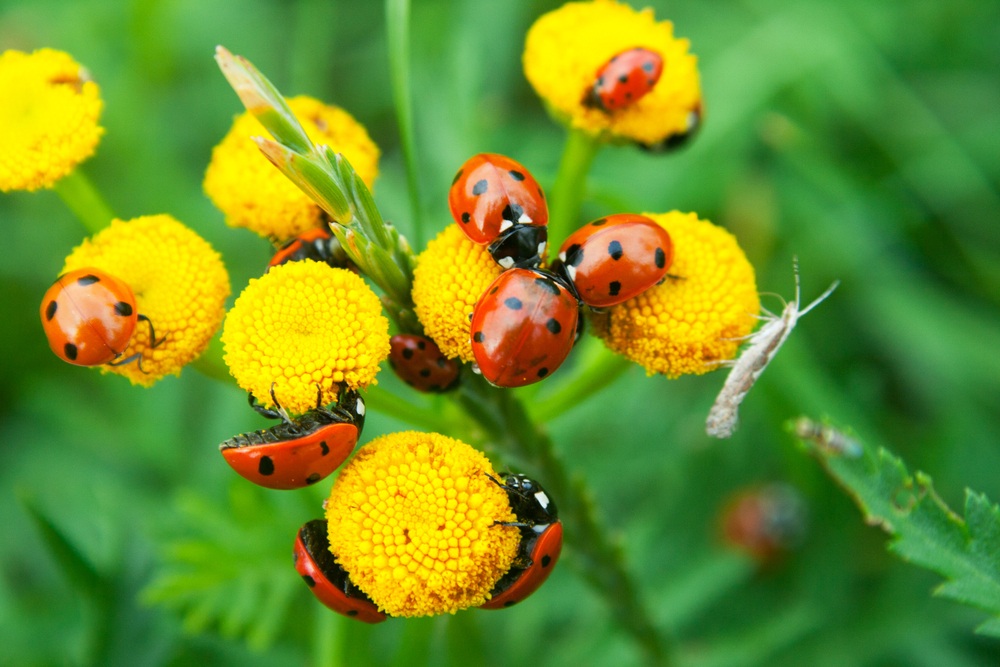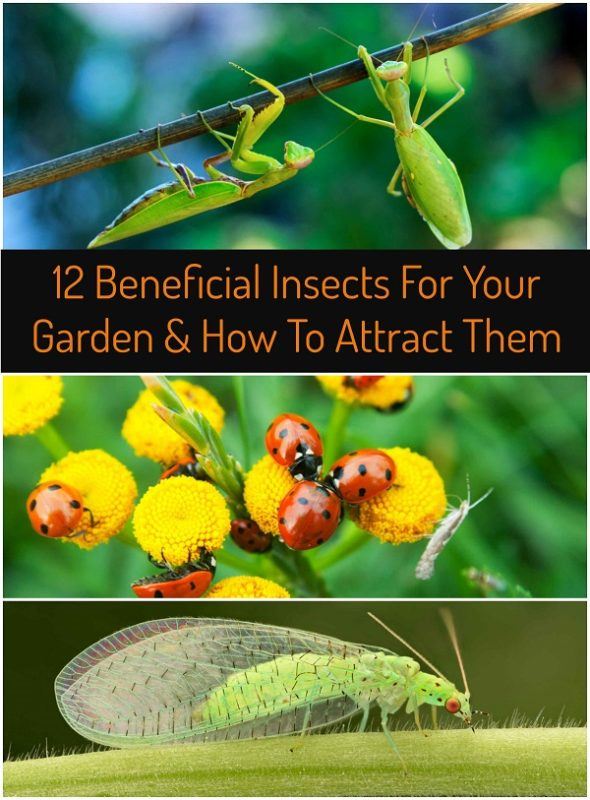
Ah, insects. The bane of every gardener and the reason that many reach for pesticides and other chemicals to eliminate their invasive presence once and for all. Surely you wouldn’t want to attract these creatures to your precious garden, right? Actually, beneficial insects could be just what you need to defeat harmful bugs for good. Here are 12 bugs that will defend your garden and tips on how to attract them.
Why You Should Attract Beneficial Insects
Before we get into our list, it is important to take a moment to consider why exactly you should turn to this method of biological pest control instead of merely grabbing the insecticide at the first sign of a spring aphid.
- You don’t have to use chemical pesticides
- This approach is totally organic
- You will save money on pest control
- You will help balance the ecosystem
- It improves your soil
- Many insects are resistant to pesticides. However, they’re not resistant to being eaten by a predator
- You will be able to attract more pollinators
- It requires little to no effort!
Remember, filling your garden with beneficial insects means that any chemical pesticide you use will harm them along with the bugs you are trying to eradicate. It is a good idea to avoid chemicals for the health and wellbeing of your family and pets as well.
1. Ladybugs
Not only are ladybugs harmless, colorful and oh-so-adorable, they are also staunch defenders of the garden. In fact, ladybugs are probably the most well-known insect that everyone wants in their yard. This is due to their serious ability to put away the nasty critters that destroy your plants. A single ladybug has been shown to be able to eat over fifty aphids every day which adds up to about five thousand in their lifetime.
They also have an appetite for mites, mealy worms, leafhoppers, and mites. As an added bonus, you don’t have to worry about ladybug larvae eating your plants or the little bugs being eaten by predators as they secrete an odor that other insects don’t like.
How to attract them: Plant dill, fennel, cilantro and yarrow in your garden to lure in orange, red, and yellow ladybugs.
However the easiest way to attract ladybugs (and a bit of a cheat) is to buy them. You can buy 1500 live ladybugs from this page on Amazon to release into your garden.
2. Tachinid Fly
Tachinid flies are known for their strange hatching habits. A tachinid fly will insert its larvae into a destructive bug, such as a Japanese beetle, gypsy moth, cabbage looper, sawfly, or tent caterpillar, to name just a few. This live host will serve as an incubator for the larvae and when it is ready to hatch, it will eat the bug from the inside out, killing it as it emerges.
Though it seems like something from a horror movie, this fascinating process is nature working at its finest. It is a good idea to get these flies on your side and encourage them to hang out in your garden for a while. Plus, tachinid flies help pollinate your garden, making them extra desirable.
How to attract them: Plant dill, parsley, clover, and other green herbs. Who doesn’t love a kitchen garden?
3. Aphid Midges
It seems like the supply of beneficial insects that love snacking on aphids is endless. These bugs are the bane of the most common garden pest and can help combat an aphid invasion.
How to attract them: As with many of the other bugs on this list, planting dill is the key to attracting these helpful critters.
4. Braconid Wasps
Another parasitic type insect. But in this case, it’s actually a good quality. Braconid wasps attach their larvae to the tomato hornworm, a serious plague for tomato growers everywhere. The larvae begin to grow and feed on the hornworm as they mature. Braconid wasps propagate extremely rapidly as well. A single female will lay between fifty to four-hundred eggs at the same time, meaning that these bugs will soon be your single greatest defense against dreaded tomato killers. Although they are technically wasps, these flying insects are friendly and will only sting if provoked.
How to attract them: Grow nectar plants with small flowers and dill, parsley, and wild carrots.
5. Praying Mantis
Though they can often seem intimidating prowling around the yard, the praying mantis is actually a wonderful creature to have around and will help you get rid of caterpillars, moths, beetles, crickets, and more.
How to attract them: They love tall grass but are also attracted to shrubs, dill, and marigolds.
You can purchase praying mantis egg cases from here with each egg case yielding 50-200 live praying mantis.
6. Ground Beetle
Ground beetles enjoy snacking on slugs, snails, cutworms, cabbage maggots, caterpillars and other bugs that spend time crawling on the ground. They are incredibly voracious as well. One ground beetle larvae will eat up to fifty caterpillars with ease.
How to attract them: Start a compost pile (if you don’t have one already) and plant lots of perennials. Ground beetles place their larvae into the ground at the end of the warm season and as they hatch, they clear the soil of bad bugs before emerging in the spring. They also aid in compost deterioration and contribute much-needed organic material to your pile.
7. Spined Soldier Bugs
Technically a stink bug, spined soldier bugs are defined (as their name would suggest) by a distinctive spine running down their backs. So if you see these guys in your garden, don’t freak out. They are the natural predators of caterpillars, beetle larvae and love to eat Colorado Potato Beetles and Mexican Bean Beetles, specifically.
How to attract them: Spined soldier bugs are attracted to colorful perennial flowers that they can return to season after season. Scatter perennials among your vegetables to lure them to the area.
8. Damsel Bugs
Even if you don’t struggle with a particular infestation, damsel bugs are a great addition to your garden. They are a wonderful go-to bug for eating harmful creatures such as mites, aphids, cabbage worms, and caterpillars.
How to attract them: Plant spearmint, fennel, and caraway to make your garden a hospitable dwelling place for damsel bugs.
9. Minute Pirate Bug
The minute pirate bug is a phenomenal insect to attract if you have a serious pest problem and your garden seems to be overrun with bad bugs. They aren’t exactly picky about their food and will pretty much eat any bugs they come across. This could potentially be concerning if you are working on building up your good bug population since they don’t discriminate in choosing a meal and may spend more time eradicating the bugs you actually do want around. However, they are particularly fond of thrips, spider mites, and aphids so they are an excellent choice if you struggle with any of those pests and have been unable to eradicate them with other natural means.
How to attract them: They will be drawn most easily by a decomposing leaf pile in a corner of the garden. However, you can also plant alfalfa and daisies to encourage the minute pirate bug to stop by.
You can also buy minute pirate bugs from Amazon – although they are very expensive.
10. Mealybug Destroyers
Though the name seems a little melodramatic, these bugs are extremely effective in dealing with mealybugs. Mealybugs look like small pieces of fluff on your plants and can leach the sap out of the stalks, causing harm and taking nutrients away from the fruit of the plant. These pests can be destructive so it is important to bring in mealybug destroyers as soon as possible.
How to attract them: You really only need to worry about attracting mealybug destroyers if you have identified a problem with mealybugs in your garden. Plant dill, goldenrod, sunflowers, and fennel to bring these knights in shining armor to the rescue of your at-risk plants.
You can also buy 25 mealybug destroyers to release into your garden from this page on Amazon.
11. Green Lacewings
Lacewings are not only a beautiful insect to watch flit around your backyard, but they are also extremely practical and eat a number of nasty pests in their larvae stage including aphids, whiteflies, leafhoppers, and mealybugs.
How to attract them: Plant coriander, angelica, or dill.
You can also purchase lacewing eggs from this page Amazon. The lacewings can eat up to 600 aphids per day while in their larvae stage.
12. Bees
Though this one should be obvious, bees are essential for the pollination of any garden. If you grow any type of fruit or vegetable or pollinating flowers, you will want to make your yard is a happy home for the bees.
How to attract them: Plant perennials, colorful annuals, and lots of fruits and veggies. Bees will come wherever there is nectar to be had. These plants are the best for a bee-friendly garden, and here are some more ways to save the bees.
More Tips For Attracting Beneficial Insects
- Keep a small dish of water in your garden for your new friends.
- Provide stones and mulch for shade and shelter.
- Grow a wide variety of plants for increased diversity in your insect population.
- Be sure to research which bugs are bad and which are good. You wouldn’t want to accidentally start killing off a bug that is doing your garden a favor. And vice versa, you don’t want to let harmful insects take over.
- Mix the plants that attract good bugs in with your other plants to ensure they’ll visit all corners of your garden.
- If you are having trouble drawing in beneficial insects, try purchasing some from your local garden center or online.
- Leave a few weeds standing to entice a wide variety of insects.
- Be sure that you are not using a bug zapper anywhere near your garden.
Pin This To Save For Later

